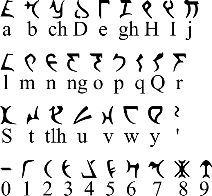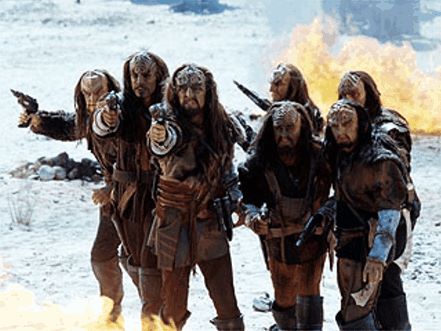Constructed Languages
Making It All Up

|
Why are they made? While auxiliary languages have a specific place in the world, they are basically tied, at least in theory, to geopolitical issues. Constructed languages are generally created for other reasons, however.  Elves from Tolkien's Middle Earth One popular reason for creating a conlang is to enhance a fictional world. Authors have created many artificial tongues to make their characters and stories seem more tangible. J.R.R. Tolkien created some of the most well known in his Middle Earth world used in his books like "The Hobbit" and "The Lord of the Rings". The characters use these languages and in some cases, they even become a part of the plot, where a character's knowledge of another language becomes crucial. Tolkien is often categorized as a linguist due to his prolific contributions to the area of fictional languages. Exactly how many he created is unknown even now, for not all of his linguistic related works have been published. It is estimated, though, that he created over twenty, some of them very complete, some only in a limited capacity, but all with their own unique vocabulary and grammar. His stories contain not only characters using the languages but also poems and songs composed for them. Television and films have also had a number of conlangs created. Besides Esperanto, Klingon, created for the Star Trek universe, is probably the most popular conlang. It is definitely the most famous alien language. Many people not only have learned it but created their own materials like courses and stories for it. There was even a man in the news that was teaching his baby son Klingon, hoping to make it bilingual with it. That kind of fanaticism upset a lot of people, however, and some even dubbed it child abuse.  Elven language and script from Tolkien's Middle Earth Klingon presents an interesting counterpoint to that IALs, in that while Esperanto and Interlingua were made specifically to be easy to learn, Klingon was designed specifically to be completely alien, literally. Its main developer, Marc Orkland, refused to even include common elements of other languages, like the sound "ah" or the verb "to be". Not only have numerous books on and in Klingon been published, an actual "Klingon Language Institute" has been established. This organization has had many major works, such as "Hamlet" and books from the Bible, translated into Klingon. While many languages learners like these mainstream creations, the real bulk of artificial language creation comes from the polyglots that want to make their own languages for fun. The temptation to make your own is very strong for some people, partially because it is also a way to develop your own ideas of a culture and world. People have always loved exploring new worlds through books, role-playing games and film, so I think this is an extension of that, giving them a chance to make their own. To me, the conlang community is like a smaller rival tribe of natural language learners. There are many websites, organizations and wikis devoted to their promotion and creation. I have met many people that had were developing their own conlangs and wanted them included alongside natural languages. One project I encountered was even devoted to creating a whole new world comprised of nations with governments and societies based around members conlangs; literally, a conplanet! Getting Serious Here is a major warning to the reader: do not treat the creation of conlangs lightly, for those involved with them take them very seriously. While they are having fun making them, it is not a trivial matter to them. They spend a huge amount of time and effort in forming the syntax, structure and vocabulary. Many create new writing systems as well as related aspects beyond language, like cultural and historical aspects. To them, they are not just playing around with words: they are creating a whole new world. Just as people take pride in their nations and languages, conlangers also have a great deal of pride caught up in their activities, and they will fight just as fiercely, if not more, to promote and defend them. I have seen many discussions turn nasty when the subject of Esperanto is brought up, but the discussion over other conlangs can be even worse. Of course, it is normal to see a few conlangers showing off their babies and taking an interest in others' creations. There are even some conlangs that are collaborations of a few people working together. They vote on grammar and syntax elements, sometimes for fun and sometimes in the creation of a new IAL. It is an entire subculture that you are essentially part of or not. The Cons of Cons  Klingon alphabet for the Klingon race of StarTrek Just like any subculture, there is a good deal of friction between conlangers and natural language learners. While there is nothing that says the two groups can not overlap, like a natural learner might also love conlangs, I have noticed there is often a strong backlash against conlangs. I mentioned earlier how there are several thousand natural living languages. To me and others, this raises the question of why would someone create a new language when there are so many out there that could be learned and, perhaps more importantly, be learned to help preserve them. Indeed, with there being a large number of endangered languages, how can one justify creating a fake one over saving a real one? Of course, logically, there is no real connection. A conlang is not going to be the thing that kills an endangered language; it is other natural languages that have done that. Most conlangers are lucky if they can get even a few people using what they make while "real" languages have clashed over the centuries, driving lesser languages into early and often almost overnight deaths. But logic has nothing to do with passion.  A group of Klingons Another reason for the friction is due to what I said before with the warning. Conlangs can easily be dismissed as something trivial, like a person creating or studying one is not really into languages. Considering the work that goes into developing a conlang, the creators might feel the same about those that do not create their own. After all, they view themselves as so serious that they are building one from scratch! Many people learn languages as part of understanding another culture or as something to use in their daily lives. To them, a conlang helps them with neither of those things. Few conlangs are actively used by anyone except the original speakers and they have no culture attached to them. Others feel that the makers of constructed languages are doing so as a way of establishing a way to mock others. They develop their "secret" language that no one else can understand. Not everyone has a real strong feeling on the issue of artificial languages and for some people, their feeling is based upon how aggressively the other side is. If a conlanger starts trying to push their creation onto others, the natural language learner will push back. This is similar to the way people often view religion: you are welcome to what you do, just do not force it on me. Indeed, that seems to be what really pushes a simple discussion into a heated debate; the attitude by one side that the other is doing something wrong and they should do like they themselves do. This is about as useless as telling someone that you are learning Polish so everyone else should be as well, or declaring that French is terrible and should never be used. Conclusion Whether you like natural languages, constructed languages, or auxillary languages, they all have followers, learners and reasons for existing. They can even help each other; a natural language can provide the inspiration and guidance in creating a constructed one, while a conlang can help give insight into how natural languages work. Rather than arguing over which is right and wrong, we should come to see the benefits of each and embrace them all as cousins in our wonderful language universe! |
| Constructed Languages - Making It All Up | ||||||
| Writer: | Erik Zidowecki | |||||
| Images: | ||||||
| ||||||
| Sources: | ||||||
| ||||||
All images are Copyright - CC BY-SA (Creative Commons Share Alike) by their respective owners, except for Petey, which is Public Domain (PD) or unless otherwise noted.
comments powered by Disqus
















